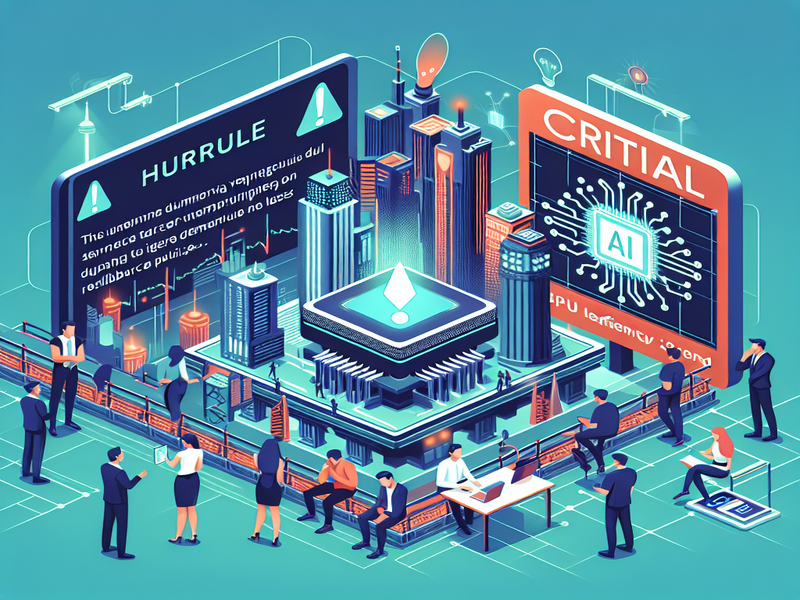- Updated: March 27, 2025
- 5 min read
OpenAI Faces GPU Challenges Amidst High Demand for ChatGPT Image Generation
OpenAI’s Image Generation Limitations: A Deep Dive into the Current Challenges and Future Prospects
In recent developments, OpenAI has faced significant challenges in managing the demand for its ChatGPT’s image generation capabilities. The surge in popularity has led to a temporary rate limit on image generation requests, as revealed by OpenAI’s CEO, Sam Altman. This article delves into the reasons behind these limitations, the technological advancements being pursued to enhance efficiency, and the broader implications for the tech industry, including updates from giants like Microsoft, Google, and Amazon.
Understanding OpenAI’s Image Generation Constraints
The fervor surrounding ChatGPT’s advanced image generation has been palpable, with users reveling in the newfound capabilities. However, this enthusiasm has come at a cost. According to Altman, the demand has been so overwhelming that it’s putting a strain on OpenAI’s infrastructure, leading to what he described as “our GPUs are melting.” This metaphorical expression highlights the intense computational load that image generation imposes on OpenAI’s systems.
As a result, OpenAI has imposed a rate limit on image generation requests to manage the load better. While Altman did not specify the exact limit, he assured users that the measure is temporary and necessary to enhance the system’s efficiency. This decision underscores the significant computational resources required for image generation, a challenge that many AI platforms face today. For more insights on how AI is revolutionizing industries, check out our article on AI in stock market trading.
Efforts to Improve Efficiency and Technological Advancements
OpenAI is actively working to improve the efficiency of its image generation processes. The company is leveraging its GPT-4o model, which has shown remarkable improvements over previous iterations. This new model not only enhances the realism of generated images but also addresses past challenges like text rendering. OpenAI describes this as a “step change” above prior models, indicating a significant leap in technological capabilities.
Moreover, OpenAI is exploring ways to optimize its GPU usage to handle the increasing demand more effectively. This involves both hardware upgrades and software optimizations to ensure that the infrastructure can support the growing number of requests without compromising performance. For businesses looking to harness AI’s potential, the Enterprise AI platform by UBOS offers robust solutions tailored to organizational needs.
Updates from Tech Giants: Microsoft, Google, and Amazon
In the broader tech landscape, companies like Microsoft, Google, and Amazon are also making strides in AI advancements. Microsoft has recently introduced a “deep reasoning” Copilot AI for research and data analysis, aiming to enhance the analytical capabilities of its tools. This move is part of Microsoft’s broader strategy to integrate AI into its suite of products, providing users with more intuitive and powerful tools.
Similarly, Google has rolled out its new “reasoning” Gemini AI models, which the company claims are its best yet. These models are designed to improve real-time AI video features, showcasing Google’s commitment to pushing the boundaries of AI technology. For those interested in the latest AI innovations, exploring the latest innovations from OpenAI can provide valuable insights.
Amazon, on the other hand, continues to expand its AI capabilities across various platforms. The company has recently added EA games to its Luna service and is launching in more countries, demonstrating its commitment to enhancing user experiences through AI-driven solutions. For a closer look at how AI is transforming retail, our article on Generative AI for the retail industry offers an in-depth analysis.
Popular Culture and AI: A Growing Intersection
Beyond technological advancements, AI’s influence is increasingly permeating popular culture. From movies to video games, AI is becoming a central theme, reflecting its growing significance in our daily lives. The recent unveiling of the gigantic cast for “Avengers: Doomsday” highlights how AI-generated content is shaping entertainment narratives, offering new possibilities for storytelling and audience engagement.
Similarly, the gaming industry is witnessing a transformation with AI-driven features, as seen in Nintendo’s March Direct showcase. These developments underscore the potential of AI to revolutionize entertainment, creating immersive experiences that captivate audiences worldwide. For those interested in AI’s role in entertainment, our article on igniting innovation with domain-specific ChatGPT explores how AI is driving creative advancements.
Conclusion: Embracing AI’s Potential and Moving Forward
As OpenAI and other tech giants continue to push the boundaries of AI technology, it’s clear that the future holds immense potential for innovation and growth. While challenges like GPU strain and infrastructure limitations persist, the ongoing efforts to enhance efficiency and technological capabilities are paving the way for a more AI-driven world.
For businesses and individuals looking to stay ahead in this rapidly evolving landscape, leveraging AI solutions is crucial. Whether it’s through ChatGPT and Telegram integration or exploring the UBOS platform overview, there are numerous opportunities to harness AI’s power for transformative outcomes.
As we embrace this new era of technological advancement, the key lies in understanding and adapting to the changes that AI brings. By staying informed and proactive, we can unlock the full potential of AI, driving innovation and progress across industries.

